 Alphabetical grammar list - This is a complete list of
all the Fun Easy English grammar terms listed in
alphabetical order. Alphabetical grammar list - This is a complete list of
all the Fun Easy English grammar terms listed in
alphabetical order. |
|
|
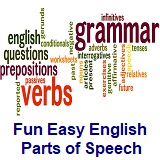 Parts of speech - explains how words are used in English
and are grouped into eight categories including: Parts of speech - explains how words are used in English
and are grouped into eight categories including:
Noun, Pronoun, Verb, Adverb, Adjective, Preposition,
Conjunction, Interjection |
-
Noun - refers to a person, animal, place, thing,
object, substance, state, event, feeling, or abstract idea
-
Pronoun - takes the place of a noun or a noun phrase
-
Verb - refers to an action (do, eat, talk) or a
state (be, like, own)
-
Adverb - modifies the meaning of other words
including: nouns, pronouns, verbs, adverbs, adjectives, phrases,
sentences
-
Adjective - modifies, or describes, a noun or a pronoun
-
Preposition - connects a noun, pronoun, or phrase to other
words in a sentence
-
Conjunction - connects phrases, clauses, or other words
-
Interjection - used mostly in speech to show emotion, gain
attention, exclaim, protest, or command
|
 Noun
- refers to a person, animal, place, thing,
object, substance, state, event, feeling, or abstract idea Noun
- refers to a person, animal, place, thing,
object, substance, state, event, feeling, or abstract idea
A noun is either
countable or
non-countable
A noun can be the
subject of a
verb, modified by an
adjective, used with an
article, used with a
determiner |
-
Abstract noun - a word used to describe
intangible concepts such as: states, events, concepts, feelings,
qualities, etc., that have no physical existence
-
Collective noun - a word used to name a group of people, animals, or things
-
Common noun - a word used to name a general person, animal, place, thing, or
abstract idea
-
Concrete noun - a word used to describe tangible objects such as: a person,
place, thing, object, or substance
-
Countable noun - a word used to describe something that can be counted
-
Non-countable noun - a word used to describe something that cannot be
counted
-
Plural noun - a word used to describe two or more things
-
Possessive noun - a
noun that owns, or is closely related to, something else
-
Proper noun - a word used to name a specific person, animal, place, or thing
-
Singular noun - a word used to describe one thing
|
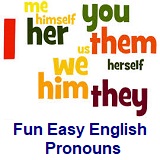 Pronoun - takes the place of a noun or a noun phrase Pronoun - takes the place of a noun or a noun phrase
A pronoun can be divided into the following types:
Demonstrative, Indefinite, Intensive, Interrogative,
Personal objective, Personal possessive, Personal
subjective, Reciprocal, Relative, Reflexive |
|
|
 Verb - refers to an action (do, eat, talk) or a
state (be, like, own) Verb - refers to an action (do, eat, talk) or a
state (be, like, own)
A verb must be included in a complete
sentence
A verb is the main element of the
predicate of a
sentence |
-
Auxiliary verb - a word that modifies the meaning of another
verb in a
sentence
-
Copula verb - a word that connects the
subject to the
complement and describes the
subject
-
Ditransitive verb - a verb which takes both a
direct object and an
indirect object
-
Dynamic verb - used in the progressive (continuous)
aspect to indicate an unfinished action
-
Finite verb - a
verb that has a subject and which shows
tense,
person, and
number
-
Gerund - a
verb which acts as a
noun by adding "ing" to the end
-
Inchoative verb - describes a change of state
-
Infinitive verb - usually occurs with "to" and has no
tense,
aspect,
person, or
number
-
Intransitive verb - does not take an
object
-
Irregular verb - does not take "ed", "d", or "t" to form
the simple past and past participle
-
Modal verb - used to express intention, necessity, obligation,
offer, permission, possibility, prohibition, question,
request, suggestion
-
Phrasal verb - a
verb with both an
adverb and a
preposition
-
Regular verb - takes "ed", "d", or "t" to form the
simple past and past participle
-
Stative verb - a word that describes a state or condition
-
Transitive verb -
a transitive verb is a
verb that takes an
object
|
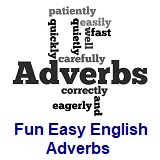 Adverb - modifies the meaning of other words
including: nouns, pronouns, verbs, adverbs, adjectives, phrases,
sentences Adverb - modifies the meaning of other words
including: nouns, pronouns, verbs, adverbs, adjectives, phrases,
sentences
An adverb can be divided into the following types:
Conjunctive, Degree, Location, Manner, Time |
|
|
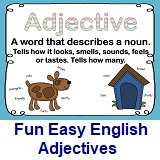 Adjective - modifies, or describes, a noun or a pronoun Adjective - modifies, or describes, a noun or a pronoun
An adjective describes the quality, state, or action that a
noun refers to |
|
|
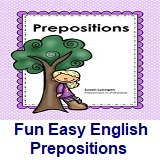 Preposition - connects a noun, pronoun, or phrase to other
words in a sentence Preposition - connects a noun, pronoun, or phrase to other
words in a sentence
A preposition can indicate direction, location, or time |
|
|
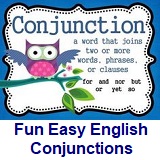 Conjunction - connects phrases, clauses, or other words Conjunction - connects phrases, clauses, or other words
A conjunction can be divided into the following types:
Coordinate, Correlative, Subordinate |
|
|
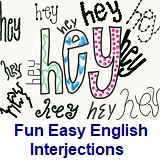 Interjection - used mostly in speech to show emotion, gain
attention, exclaim, protest, or command Interjection - used mostly in speech to show emotion, gain
attention, exclaim, protest, or command
An interjection is not grammatically related to any other part of a
sentence |
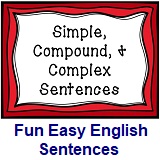 Sentence - contains a
subject
and a
predicate Sentence - contains a
subject
and a
predicate
In a sentence:
The
subject
tells who or what the sentence is about
The
predicate gives information about the
subject
The
predicate of a sentence always includes a
verb |
-
Simple sentence - the most basic type of sentence which contains only one
independent clause
-
Compound sentence - has two or more independent clauses or simple sentences
which are connected using coordinate conjunctions
-
Complex sentence - has one independent clause and at least one dependent clause
but differs from a compound sentence in that the clauses are
not equal
-
Compound - complex sentence - composed of a simple sentence and a complex sentence or two
complex sentences
-
Declarative sentence - used most often in spoken and written English and is used to
state facts or an argument
-
Exclamatory sentence - the same as a declarative sentence except that it adds
emphasis and usually ends with an exclamation mark
-
Imperative sentence - used to give a direct command to someone and can end with a
period or an exclamation mark depending on the degree of the
command
-
Interrogative sentence - used to ask a direct question and always ends with a
question mark
-
Loose sentence - a long sentence that has the main point at the beginning and
typically used by English speakers
-
Periodic sentence - a long sentence that has the main point at the end and
although not typically used, this type of sentence can be
dramatic or even persuasive
|
 Punctuation - used to indicate the structure and
organization of writing, as well as intonation and pauses to
be observed when reading it aloud Punctuation - used to indicate the structure and
organization of writing, as well as intonation and pauses to
be observed when reading it aloud
Punctuation is everything in written language besides the actual
letters or numbers |
-
Apostrophe -
' or ’
used to indicate omitted letters such as abbreviations and
contractions and to indicate possession
-
Brackets -
( ) or [ ]
or
< > or { }
used in pairs to set apart or interject text within a
written text
-
Colon - : used to introduce lists
and to connect a broad idea with a specific example
-
Comma - , used to separate elements in a
sentence, introductory
clause, words in a series, parenthetical
phrase, or
interjection and to separate items in lists, and to present large numbers in
a more readable form
-
Dash - en dash
–, em dash —, and
quotation dash ― used as a "strong" separator where a
comma is not enough
-
Exclamation mark - !
indicates the end of a
sentence that is either an actual exclamation, or is
intended to be astonishing in some way
-
Hyphen - - used both to join words and to separate syllables
-
Period -
. commonly placed at the end of several different types of
sentences
-
Question mark - ? like a
period but is used in
interrogative sentences
-
Quotation marks - ' ' or
‘ ’ or
" " or
“ ” used to set off speech, a quotation, or a
phrase
-
Semicolon - ; used to join two
sentences more closely than they would be joined
if separated by a
period
-
Slash - / used to replace the
hyphen to make clear a strong joint
between words or
phrases
|
|